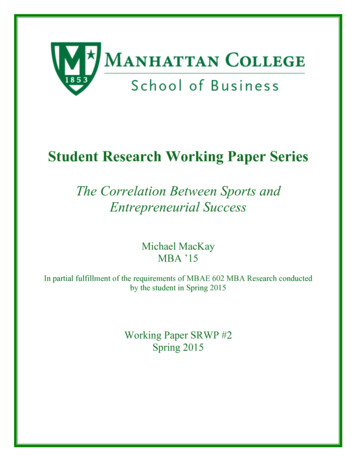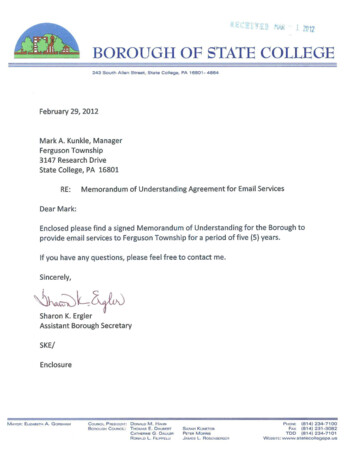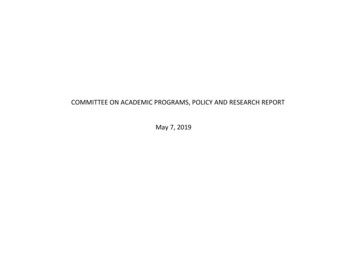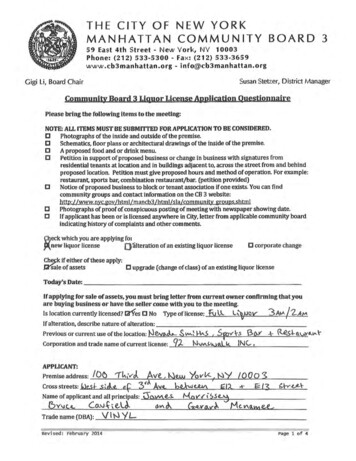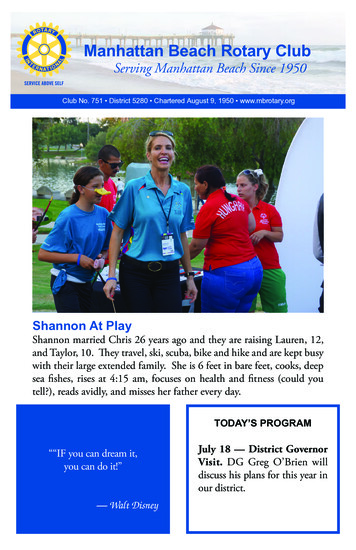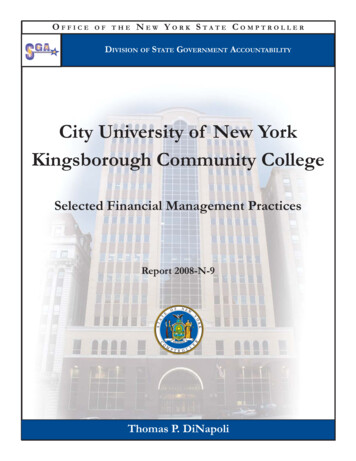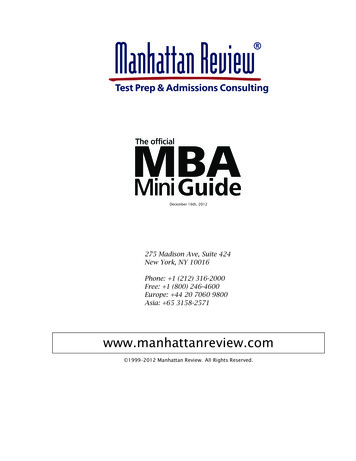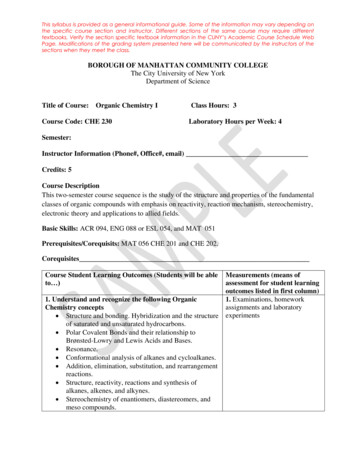
Transcription
This syllabus is provided as a general informational guide. Some of the information may vary depending onthe specific course section and instructor. Different sections of the same course may require differenttextbooks. Verify the section specific textbook information in the CUNY’s Academic Course Schedule WebPage. Modifications of the grading system presented here will be communicated by the instructors of thesections when they meet the class.BOROUGH OF MANHATTAN COMMUNITY COLLEGEThe City University of New YorkDepartment of ScienceTitle of Course:Organic Chemistry ICourse Code: CHE 230Class Hours: 3Laboratory Hours per Week: 4Semester:Instructor Information (Phone#, Office#, email)Credits: 5Course DescriptionThis two-semester course sequence is the study of the structure and properties of the fundamentalclasses of organic compounds with emphasis on reactivity, reaction mechanism, stereochemistry,electronic theory and applications to allied fields.Basic Skills: ACR 094, ENG 088 or ESL 054, and MAT 051Prerequisites/Corequisits: MAT 056 CHE 201 and CHE 202.CorequisitesCourse Student Learning Outcomes (Students will be ableto )1. Understand and recognize the following OrganicChemistry concepts Structure and bonding. Hybridization and the structureof saturated and unsaturated hydrocarbons. Polar Covalent Bonds and their relationship toBrønsted-Lowry and Lewis Acids and Bases. Resonance. Conformational analysis of alkanes and cycloalkanes. Addition, elimination, substitution, and rearrangementreactions. Structure, reactivity, reactions and synthesis ofalkanes, alkenes, and alkynes. Stereochemistry of enantiomers, diastereomers, andmeso compounds.Measurements (means ofassessment for student learningoutcomes listed in first column)1. Examinations, homeworkassignments and laboratoryexperiments
This syllabus is provided as a general informational guide. Some of the information may vary depending onthe specific course section and instructor. Different sections of the same course may require differenttextbooks. Verify the section specific textbook information in the CUNY’s Academic Course Schedule WebPage. Modifications of the grading system presented here will be communicated by the instructors of thesections when they meet the class. Structure, reactivity, and synthesis of alkyl halides.Nucleophilic substitution and elimination reactions ofalkyl halides.Synthetic organic techniques for the building of smalland large molecules and to show their relationshipwith biological structures.Organic laboratory techniques and skills to synthesize,separate, purify and characterize organic compounds.Below are the college’s general education learning outcomes, the outcomes that are checkedin the left-hand column indicate goals that will be covered and assessed in this course.(Check at least one.)General Education Learning OutcomesXXCommunication Skills- Students will beable to write, read, listen and speakcritically and effectively.Quantitative Reasoning- Students will beable to use quantitative skills and theconcepts and methods of mathematics tosolve problems.Scientific Reasoning- Students will be ableto apply the concepts and methods of thenatural sciences.Social and Behavioral Sciences- Studentswill be able to apply the concepts andmethods of the social sciences.Arts & Humanities- Students will be ableto develop knowledge and understanding ofthe arts and literature through critiques ofworks of art, music, theatre or literature.Information & Technology LiteracyStudents will be able to collect, evaluate andinterpret information and effectively useinformation technologies.Values- Students will be able to makeinformed choices based on an understandingof personal values, human diversity,multicultural awareness and socialresponsibility.Measurements (means of assessment forgeneral education goals listed in firstcolumn)To record experimental data and to use toplot graphs and calculate reactantconcentrations, limiting reagents,theoretical yield and percentage yields%Exam questions, homework assignment,laboratory assignments and case study
This syllabus is provided as a general informational guide. Some of the information may vary depending onthe specific course section and instructor. Different sections of the same course may require differenttextbooks. Verify the section specific textbook information in the CUNY’s Academic Course Schedule WebPage. Modifications of the grading system presented here will be communicated by the instructors of thesections when they meet the class.Required Text1.Organic Chemistry, 3rd Ed by David Klein, John Wiley & Sons, Inc., 2017ISBN 978-1-119-31615-2Other Resources (Highly recommended)1.Student Study Guide and Solutions Manual by David Klein, Edition binder readyversion, ISBN: 978-1-119-42253-2 John Wiley & Sons, Inc., 2017.2. A small Scale Approach to Organic laboratory Techniques , 3rd Ed. by Donald Pavia,Gary Lampman, George Kriz and Randall Engel, Brooks/Cole Cengate Learning, 2011ISBN-13: 978-1-4390-4932-7 and ISBN-10: 1-4390-49323. Lab coats or aprons4. Molecular modeling kitEvaluation and Requirements of StudentsThe laboratory will be evaluated in preparation, work, and report. A student who is absent frommore than one laboratory session seriously jeopardizes his/her grade for the course.The students are encouraged to work as many problems found at the end of the chapter until themain content of the chapter is mastered. The use of the molecular models is recommended tovisualize the stereochemistry and the three-dimensional aspect of the organic compounds. TheStudent Study Guide and Solutions Manual is useful for checking your answers.Outline of TopicsChapterLecture Topics11.1 to 1.13A Review of General Chemistry: Electrons, Bonds, and MolecularPropertiesThe Structural Theory of Matter. Electrons, Bonds, and Lewis Structures.Formal Charges. Induction and Polar Covalent Bonds. Atomic Orbitals.Valence Bond and Molecular Orbital Theory. Hybridized Atomic Orbitals.VSEPR. Dipole Moments and Polarity. Intermolecular Forces and PhysicalProperties. Solubility.22.1 to 2.13Molecular RepresentationsMolecular Representations. Bond-Line Structures. Functional Groups.Formal Charges. Lone Pairs. Three-Dimensional Structures. Resonance.Curved Arrows. Formal Charges in Resonance Structures. DrawingResonance Structures via Pattern Recognition. Assessing RelativeImportance of Resonance Structures. Resonance Hybrid. Delocalized andLocalized Lone Pairs.
This syllabus is provided as a general informational guide. Some of the information may vary depending onthe specific course section and instructor. Different sections of the same course may require differenttextbooks. Verify the section specific textbook information in the CUNY’s Academic Course Schedule WebPage. Modifications of the grading system presented here will be communicated by the instructors of thesections when they meet the class.33.1 to 3.9Acids and BasesBronsted-Lowry Acids and Bases, Acidity. Flow of Electron Density:Curved Arrow Notation. Position of Eqilibrium and Choice of reagents.Levelling Effects. Solvating Effects. Counterions. Lewis Acids and Bases.44.1 to 4.15Alkanes and CycloalkanesAlkanes: Introduction, Nomenclature, Constitutional Isomers, RelativeStability of Isomers, Sources and Uses. Newman Projections.Conformational Analysis of Ethane, Propane, and Butane. Cycloalkanes:Conformations, Monosubstituted and Disubstituted. Cyclohexane:Conformations, cis-trans Stereoisomerism. Polycyclic Systems.55.1 to 5.11StereoisomerismIsomerism. Stereoisomerism. Configuration Using the Cahn-lngold-PrelogSystem. Optical Activity. Enantiomers and Diastereomers. Symmetry andChirality. Fischer Projections. Conformationally Mobile Systems.Resolution of Enantiomers. E and Z Designations.66.1 to 6.12Chemical Reactivity and MechanismEnthalpy. Entropy. Gibbs Free Energy. Equilibria. Kinetics. EnergyDiagrams. Nucleophiles and Electrophiles. Arrow Pushing. Drawing CurvedArrows. Carbocation Rearrangements. Reversible and Irreversible reactionarrows.77.1 to 7.13Alkyl Halides: Nucleophilic Substitution and Elimination ReactionsIntroduction to Substitution and Elimination Reactions. Nomenclature anduses of Alkyl Halides. SN2 Reactions. E2 Reactions. Nomenclature andstability of alkenes. Regiochemical and Stereochemical Outcomes for E2Reactions. Unimolecular reactions. Kinetic Isotope Effects in Eliminationreactions. Predicting Products: Substitution vs. Elimination. Substitutionand Elimination Reactions with Other Substrates. Synthetic Strategies.88.1 to 8.14Addition Reactions of AlkenesIntroduction to Addition Reactions. Addition vs. Elimination.Hydrohalogenation. Acid-Catalyzed Hydration. OxymercurationDemercuration. Hydroboration-Oxidation. Catalytic Hydrogenation.Halogenation and Halohydrin Formation. Anti and Syn Dihydroxylation.Oxidative Cleavage. Predicting Products of an Addition Reaction. SynthesisStrategies.99.1 to 9.11AlkynesAlkynes: Introduction, Nomenclature, Preparing, Reduction,Hydrohalogenation, Hydration, Halogenation, Ozonolysis. Acidity ofAcetylene and Terminal Alkynes. Alkylation of Terminal Alkynes.Synthesis Strategies.
This syllabus is provided as a general informational guide. Some of the information may vary depending onthe specific course section and instructor. Different sections of the same course may require differenttextbooks. Verify the section specific textbook information in the CUNY’s Academic Course Schedule WebPage. Modifications of the grading system presented here will be communicated by the instructors of thesections when they meet the class.1010.1 to 10.10And 10.13Radical ReactionsRadicals. Radical Mechanisms. Chlorination of Methane. Halogenation:Thermodynamic Considerations , Regioselectivity, and Stereochemistry.Allylic Bromination. Autooxidation and Antioxidants. Halogenation as aSynthetic Technique.Experiments:Experiment TitleWeekLaboratory Safety and Laboratory Rules, Check-in1Melting Point Determination2Purification of Acetanilide3Simple and Fractional Distillation4Conformers of Alkanes and Cycloalkanes5Isolation and Purification of Caffeine67Synthesis and Purification of AcetaminophenOil of Cinnamon8910Synthesis of Cyclohexene1011SN1/SN2 reactions12Synthesis of Butyl BromideCheck out131415Class ParticipationParticipation in the academic activity of each course is a significant component of the learningprocess and plays a major role in determining overall student academic achievement. Academicactivities may include, but are not limited to, attending class, submitting assignments, engagingin in-class or online activities, taking exams, and/or participating in group work. Each instructorhas the right to establish their own class participation policy, and it is each student’sresponsibility to be familiar with and follow the participation policies for each course.
This syllabus is provided as a general informational guide. Some of the information may vary depending onthe specific course section and instructor. Different sections of the same course may require differenttextbooks. Verify the section specific textbook information in the CUNY’s Academic Course Schedule WebPage. Modifications of the grading system presented here will be communicated by the instructors of thesections when they meet the class.BMCC is committed to the health and well‐being of all students. It is common for everyone toseek assistance at some point in their life, and there are free and confidential services on campusthat can help.Single Stop www.bmcc.cuny.edu/singlestop, room S230, 212‐220‐8195. If you are havingproblems with food or housing insecurity, finances, health insurance or anything else that mightget in the way of your studies at BMCC, come by the Single Stop Office for advice andassistance. Assistance is also available through the Office of Student Affairs, S350, 212‐220‐8130.Counseling Center www.bmcc.cuny.edu/counseling, room S343, 212‐220‐8140. Counselorsassist students in addressing psychological and adjustment issues (i.e., depression, anxiety, andrelationships) and can help with stress, time management and more. Counselors are available forwalk‐in visits.Office of Compliance and Diversity www.bmcc cuny.edu/aac, room S701, 212-220-1236.BMCC is committed to promoting a diverse and inclusive learning environment free of unlawfuldiscrimination/harassment, including sexual harassment, where all students are treated fairly. Forinformation about BMCC's policies and resources, or to request additional assistance in this area,please visit or call the office, or email olevy@bmcc.cuny.edu, or twade@bmcc.cuny.edu. If youneed immediate assistance, please contact BMCC Public safety at 212-220-8080.Office of Accessibility www.bmcc.cuny.edu/accessibility, room N360 (accessible entrance: 77Harrison Street), 212-220-8180. This office collaborates with students who have documenteddisabilities, to coordinate support services, reasonable accommodations, and programs thatenable equal access to education and college life. To request an accommodation due to adocumented disability, please visit or call the office.BMCC Policy on Plagiarism and Academic Integrity StatementPlagiarism is the presentation of someone else’s ideas, words or artistic, scientific, or technicalwork as one’s own creation. Using the idea or work of another is permissible only when theoriginal author is identified. Paraphrasing and summarizing, as well as direct quotations, requirecitations to the original source. Plagiarism may be intentional or unintentional. Lack of dishonestintent does not necessarily absolve a student of responsibility for plagiarism. Students who areunsure how and when to provide documentation are advised to consult with their instructors. Thelibrary has guides designed to help students to appropriately identify a cited work. The fullpolicy can be found on BMCC’s Web site, www.bmcc.cuny.edu. For further information onintegrity and behavior, please consult the college bulletin (also available online).
Organic laboratory techniques and skills to synthesize, separate, purify and characterize organic compounds. Below are the college’s general education learning outcomes, the outcomes
